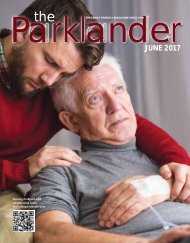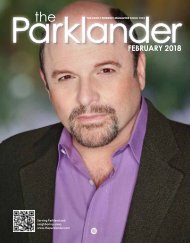January 2017
You also want an ePaper? Increase the reach of your titles
YUMPU automatically turns print PDFs into web optimized ePapers that Google loves.
HEALTH<br />
by Marcy Albin<br />
CBD and<br />
THC:<br />
The Questionable<br />
Green Stuff<br />
Globally, people from the Americas to the shores<br />
of Europe are in heated debate regarding the<br />
medicinal effects and the therapeutic benefits<br />
of cannabis. This is, of course, due to the fact that<br />
there is clinical evidence that shows cannabis and<br />
its components have the ability to treat a number of<br />
neurological and cancer-related disorders, as well as<br />
other pain related issues.<br />
Florida voters on the<br />
recent Election Eve,<br />
overwhelmingly<br />
approved a<br />
constitutional amendment guaranteeing<br />
seriously ill patients the right to medical marijuana.<br />
This was a victory for decriminalization supporters<br />
who narrowly lost a similar ballot fight two years ago.<br />
According to<br />
unofficial results,<br />
Amendment 2<br />
had more than<br />
71 percent of<br />
the vote.<br />
The newly approved Amendment 2 allows patients with<br />
illnesses of the “same kind or class, as or comparable to”<br />
cancer, HIV, post-traumatic stress disorder, Parkinson’s<br />
disease, and epilepsy to obtain marijuana through stateapproved<br />
doctors and state-approved dispensaries.<br />
According to The Deparment of Health in Tallahassee,<br />
about 450,000 Floridians would qualify to use the drug<br />
under these rules. Florida law already permits patients<br />
with certain conditions, such as uncontrollable<br />
seizures, to use non-euphoric types of cannabis. Another law<br />
adopted in 2016 allows terminally ill patients to use full-strength<br />
marijuana.<br />
Currently, with the majority of the American population,<br />
Canada, Brazil, Australia, and other countries in the European<br />
Union, having easy access to some form of legal cannabis,<br />
we now face a need to sit down and educate ourselves and<br />
to be knowledgeable consumers and improved health care<br />
professionals<br />
Cannabis based medications have<br />
been used for centuries. Here is a brief<br />
breakdown of the cannabinoids.<br />
The endocannabinoid system is a group of neuromodulatory<br />
lipids and their receptors in the brain and throughout the<br />
central and peripheral nervous systems. They are involved in<br />
a variety of physiological processes including appetite, painsensation,<br />
mood, and memory, and mediate the psychoactive<br />
effects of cannabis.<br />
The best known part of the cannabinoid is THC, or<br />
tetrahydrocannabinol. THC has been shown to bind the CB1<br />
receptors, and induce an intoxicating effect, called a “high.”<br />
Since then, THC has been tested and has shown to effectively<br />
treat pain associated with cancer successfully. THC, however,<br />
is only one of the 70 or more cannabinoids found in the THC<br />
plant.<br />
The second most important cannabinoid is<br />
CBD, or cannabidiol; it is non-intoxicating,<br />
and shows signs of controlling<br />
seizures, anxiety, nausea, vomiting, and<br />
other dysfunctions.<br />
88<br />
JANUARY <strong>2017</strong>


















